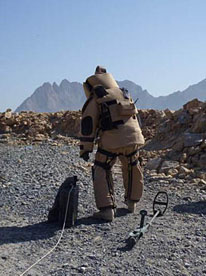Training Afghan bomb disposal teams
As they headed to a training session across a dusty, grassy field in Mazar-e-Sharif, the most eagle-eyed member of the group noticed a wire sticking out of the ground. As his fellow Afghan bomb disposal experts-in-training continued on their way, Abudlmanan Shaki Shah stayed silent, thanked his lucky stars, and dropped to his knees to begin completing the task he had spent weeks preparing for.

For the next couple of minutes, he painstakingly covered the wire with disarming material. After checking his work one last time, he shouted to his colleagues in the Afghan National Army (ANA) Explosives Ordnance Disposal (EOD) team. They rushed over to inspect the situation. But instead of heaping praise on their zealous colleague, roars of laughter erupted as the wire was uncovered and found to be a hose, albeit painted the same colour as an Improvised Explosive Device (IED) wire. This time, the discovery was harmless.
For Staff Sergeant Shaki Shah, 26, of the 1st Brigade RCC Battalion of 205th Hero Corps, it was the funniest and most unforgettable moment of his training by NATO forces to be an elite Afghan bomb disposal expert. “Whenever we disarm a roadside IED, both I and the team feel very proud of our jobs, because if we left the IED behind, or don’t do anything, it may kill civilians, or destroy houses or Coalition and Afghan National Security Forces,” he says. “My parents think this is a good job and they respect me for doing it,” he adds.
The course was initially tough, particularly getting and using the specialised equipment required to disarm IEDs. However, Shaki Shah says that with the help of his trainers it has been no more demanding than he expected. “It needs to be mentioned, that the way the trainers taught us was outstanding,” he says with a smile.
Bringing experience to the field
 One of those trainers was Technical Sergeant Ryan Otero, 31, of the United States Air Force. After doing well in his military tests, Air Force recruitment told him he could have the pick of jobs available. He chose to become a bomb disposal expert and is now on his third deployment to Afghanistan, this time training the ANA EOD battalions. “I didn’t go into the recruiter’s office wanting to be a bomb technician,” he says, adding that when he was told EOD were recruiting, he had to ask what section that was. But once explained, and much to the chagrin of his parents, he knew what he wanted to spend his life doing.
One of those trainers was Technical Sergeant Ryan Otero, 31, of the United States Air Force. After doing well in his military tests, Air Force recruitment told him he could have the pick of jobs available. He chose to become a bomb disposal expert and is now on his third deployment to Afghanistan, this time training the ANA EOD battalions. “I didn’t go into the recruiter’s office wanting to be a bomb technician,” he says, adding that when he was told EOD were recruiting, he had to ask what section that was. But once explained, and much to the chagrin of his parents, he knew what he wanted to spend his life doing.
Working with the ANA has been a rewarding experience says Otero, “The ANA are a motivated bunch. I’ve done most of what there is to do in the combat realm. This was something new and different which is why I volunteered to do it.” Together with his team partner, Otero brings to the training the experience of having diffused almost 500 bombs. He also contributes extensive logistical and practical knowledge that comes from being part of a small unit that gets attached to bigger ones in combat.
A long recruitment process
ANA bomb disposal recruits are chosen by Task Force Paladin, a specialised bomb-hunting unit, or one of the ANA EOD units themselves. Once selected, recruits must sit and pass literacy and maths tests before being enrolled into the first phase of the EOD school. At this level they are taught basic methods to deal with unexploded ordnance on the battlefield. After completing this training, they can choose to go back to their unit or continue to IED training. After completing the second level of training, its time for Otero and his colleagues to teach them team interoperability and how to conduct operations. Initially the ANA are observers on operations, but as they progress through training roles are reversed and Otero’s team monitor them. Once certified, they go back to their units to conduct independent operations.
Although he talks of the odd miscommunication such as hearing ‘curry juice’ instead of ‘courageous’, Otero sings the praises of his Afghan colleagues, noting the motivation and the honour with which they do their tasks. “I know they recognize many of the problems they face themselves,” he explains.
Otero adds that the Afghan recruits are very similar to their NATO counterparts. “There are a lot of commonalities, one of the first things we bonded over was the mutual love EOD guys have for giant watches. It’s just one of those universal things, that if you’re an EOD guy your watch needs to have a satellite uplink, microwave oven and a remote control all on a sundial-sized watch.”
Nevertheless, some logistical issues remain a problem. “There isn’t a book with all the answers in it,” he explains, describing how he overcomes these issues to ensure the smooth progress of the intense training process. “It’s where your personality gets to shine through a little,” he adds. “I personally believe that preparing organic Afghan forces is the way ahead, it’s the future of this country and something I’m proud to be given the opportunity to be part of.”
